I’m delighted to introduce you to Kristine Albrecht from Santa Cruz Dahlias. I first discovered Kristine via a photo she posted of ‘KA’s Cloud,’ a huge soft pink dahlia she bred. I was instantly obsessed and just had to have that dahlia! And I just HAD to get to know this fellow dahlia lover better. After bugging Kristine with lots of questions, we quickly became flower friends, thanks to the power of Instagram.
Kristine generously shared some of her KA’s Cloud dahlia tubers with me last spring and I fell in love. These massive blush kissed, white blooms have long, strong stems and produce abundant big blooms all season long. I added KA’s Cloud to my list of must-grow dahlias and was thrilled to have Floret serve as just one of a handful of retailers offering this beauty for sale. (And because know I’ll be asked: yes, we are sold out)
Kristine currently serves as President of the Monterey Bay Dahlia Society and on the Executive Board of the American Dahlia Society (ADS). She is currently working with ADS to get the dahlia genome sequenced. Kristine has been extraordinarily generous with her knowledge and I’ve learned a lot about the incredible process of breeding dahlias from her. I asked Christine to share more about growing and breeding dahlias as part of our Farmer and the Florist series of interviews here on the blog. If you love dahlias as much as I do, you’ll want to pull up a chair for this one!
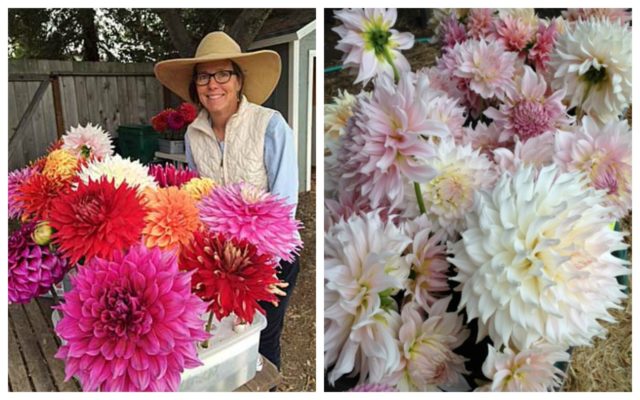
Erin: Kristine, thanks so much for doing this interview with me! For readers not familiar with your farm and business, start out by sharing a little bit about how you got started.
Kristine Albrecht: My son and I had been growing giant pumpkins for seven years (875 lbs was our largest pumpkin) when one day he stated he was done growing. It was 2006, he was entering junior high, and he had lost interest. I knew I would need to put something in place not only to satisfy my love for plants but my kids, both of them, were needing me less and less. My nurturing energies needed to go somewhere. My husband and I owned a quarter acre of undeveloped, flat, weed infested, deer-free land in a suburban neighborhood in Santa Cruz, California. It’s a half mile from the beach and five minutes from our house. I had grown a few dahlias at home and my husband had loved them. He asked if I could grown dahlias for our family’s bed and breakfast. Blackbird Farm (later Santa Cruz Dahlias) was born. When I do something I typically go all out. I cleared the quarter acre and planted 500 dahlia tubers my first year. Next, I joined the Monterey Bay Dahlia Society to learn more. I approached a local florist that first year. She told me that her dahlia supplier had moved away and so I and started supplying her 300 – 400 blooms a week. I do most of the labor myself, although I have help with disbudding, weeding, designing and any heavy lifting.
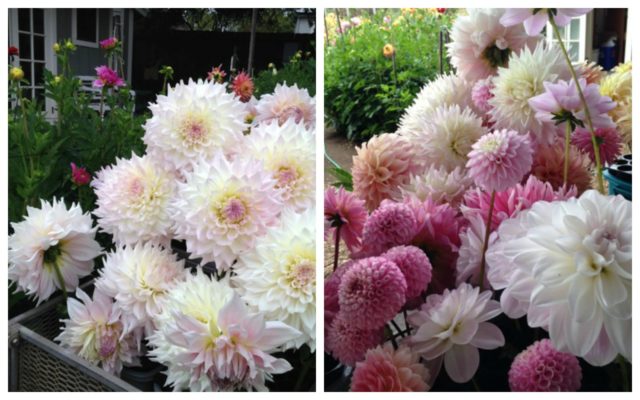 Erin: Can you describe your operation, how your business is structured and what you specialize in?
Erin: Can you describe your operation, how your business is structured and what you specialize in?
Kristine Albrecht: I now have 1,200 dahlias plants and supply three florists with blooms. I also have a farm stand, and grow blooms for designers throughout Northern California.
I have kept the business part of the farm intentionally small as I want to have time and energy to grow dahlias for show and to cultivate new hybrids. These two interests take much work and come into full swing just as the dahlia blooms are taking off. On a typical August weekend my friend Iris and I will drive 100-200 blooms to a regional bloom show. When located in the west, I will show at the national show. Most shows are in the Bay Area but we once drove blooms to Portland, Oregon, a 12 hour drive. Bringing blooms to far away shows requires keeping the blooms cool. I do this by blasting the car’s air conditioner while wearing a down jacket, a winter hat, and down gloves. I drive with aluminum foil covering the windows to keep the sun off the blooms.
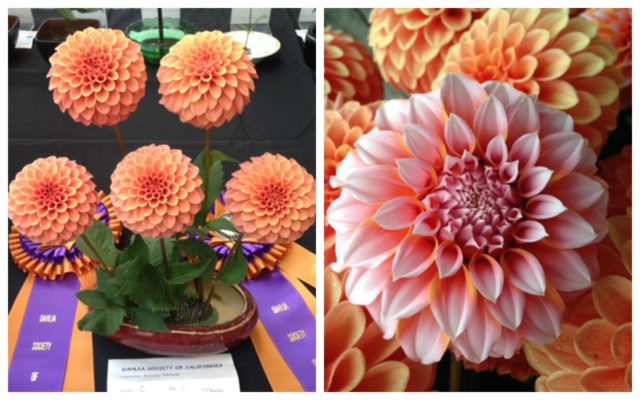 Dahlia shows are like dog shows but with dahlias. You have to bring your very best blooms to be judged against all the blooms in the show in all the different categories. Trained judges eventually pick the best bloom of the entire show. Blooms need to be as close to perfect as you can grow them- no bug damage, nice looking foliage free of powdery mildew, fresh with no petal damage, and the blooms must be at their peak. I have been so very lucky to have a two good friends, Jan and Iris, who help me grow and show my dahlias. This makes all my adventures that much more fun. Jan is a natural floral designer using our blooms to win top awards at most of the shows and Iris (an amazing award-winning dahlia grower herself) keeps spreadsheets on all the tubers so we know what we have to plant each year.
Dahlia shows are like dog shows but with dahlias. You have to bring your very best blooms to be judged against all the blooms in the show in all the different categories. Trained judges eventually pick the best bloom of the entire show. Blooms need to be as close to perfect as you can grow them- no bug damage, nice looking foliage free of powdery mildew, fresh with no petal damage, and the blooms must be at their peak. I have been so very lucky to have a two good friends, Jan and Iris, who help me grow and show my dahlias. This makes all my adventures that much more fun. Jan is a natural floral designer using our blooms to win top awards at most of the shows and Iris (an amazing award-winning dahlia grower herself) keeps spreadsheets on all the tubers so we know what we have to plant each year.
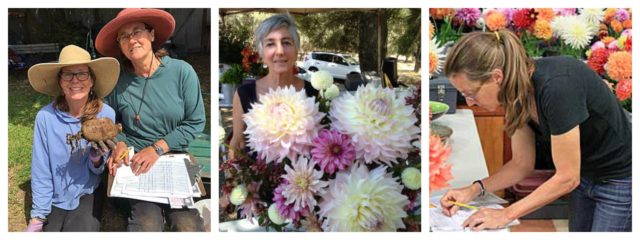
Erin: Can you take us on a little tour of your farm? What is the set up like and how do you lay out your planting areas? It seems like you are very meticulous when it comes to growing top quality plants. Any growing tips you’d care to share?
Kristine Albrecht: The Farm is laid out in eleven 70 foot rows with six feet of walking space between each row. We have three lines of T-tape for watering each row. The T-tape is fed by a 3/4” pipe that is connected to a hose and then to the faucet. The T-tapes is set 8” apart and we plant two lines of dahlias in each row. The dahlia tubers are planted 4” to 6” deep 18 to 24” apart zigzagging down the inside of the of the outer-most T-tapes. We stake to support the dahlias. We plant like sizes and varieties together. It makes cutting easier for the shows and for our customers.
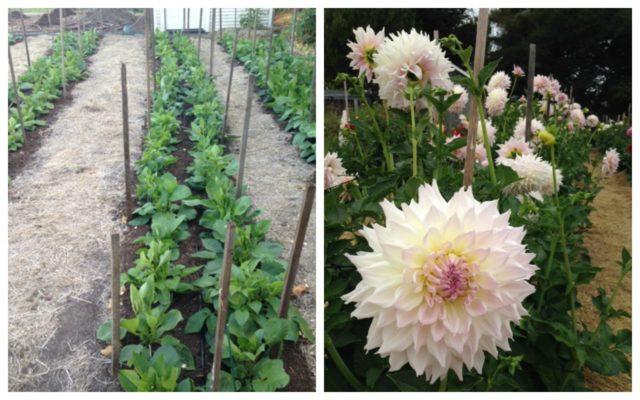 Because we show our blooms, we try hard to keep pests and powdery mildew at a minimum. We try to spray our dahlias every ten to 14 days. We grow organically so the sprays we use are OMR approved. I like using horticultural oil for powdery mildew and aphids and other soft bodied pests. I use Captain Jack’s Dead Bug Brew for cucumber beetles and any other munching bugs. We have powdery mildew here by the coast so we have to think preventative all the time. We try to grow really clean blooms since show blooms have to be close to perfect to place at shows.
Because we show our blooms, we try hard to keep pests and powdery mildew at a minimum. We try to spray our dahlias every ten to 14 days. We grow organically so the sprays we use are OMR approved. I like using horticultural oil for powdery mildew and aphids and other soft bodied pests. I use Captain Jack’s Dead Bug Brew for cucumber beetles and any other munching bugs. We have powdery mildew here by the coast so we have to think preventative all the time. We try to grow really clean blooms since show blooms have to be close to perfect to place at shows.
Erin: You created KA’s Cloud as a cross between ‘Elma Elizabeth’ and ‘Kenora Jubilee’. Walk me through the steps involved with creating a new cultivar. I’m particularly interested in learning more about your process. If you have photos of the key steps, that would be amazing.
Kristine Albrecht: There are two ways to create a new cultivar: pollinating by hand or letting the bees do the work. Our own cultivar, KA’s Cloud, was a hand-cross between Elma Elizabeth and Kenora Jubilee. I covered the new buds on both plants with a netting called tulle and waited for the blooms to show pollen. Then I stripped all but a few petals off both blooms and cut the Kenora Jubilee bloom from the plant. I brought the cut bloom over to the exposed Elma Elizabeth and gently brushed the Kenora Jubilee pollen onto Elma Elizabeth’s bloom center. The Kenora Jubilee bloom I put in water in my shed so the bees couldn’t come and mix in random pollen. I then wrapped up Elma Elizabeth to protect her from any bee pollination. I did this same procedure three times over the next few days.
I usually cross pollinate between 11am -1pm after the blooms have dried off from the coastal fog. I pollinate in late August and early September so I have about four weeks before the rain that makes seed collecting impossible.
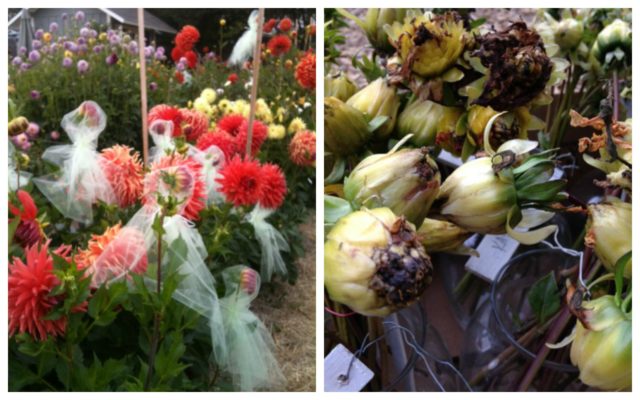 The seed pod continues to mature and eventually turns a straw green color with a tiny black tip. I then remove the tulle and harvest the seeds from the pod. I take the seeds from the pod immediately so they don’t mold. I dry the seeds out on a paper towel for 24 hours and store them in paper envelopes for the winter in a cool dry place.
The seed pod continues to mature and eventually turns a straw green color with a tiny black tip. I then remove the tulle and harvest the seeds from the pod. I take the seeds from the pod immediately so they don’t mold. I dry the seeds out on a paper towel for 24 hours and store them in paper envelopes for the winter in a cool dry place.
I keep records on the seed parents. This information is important as some dahlias are much better seed parents than others. For example, Cafe au Lait is a good seed parent and KA’s Cloud is too. I’ve never been successful getting any seed from the huge dahlia Emory Paul. By tracking this information I know which dahlias I should avoid in future years.
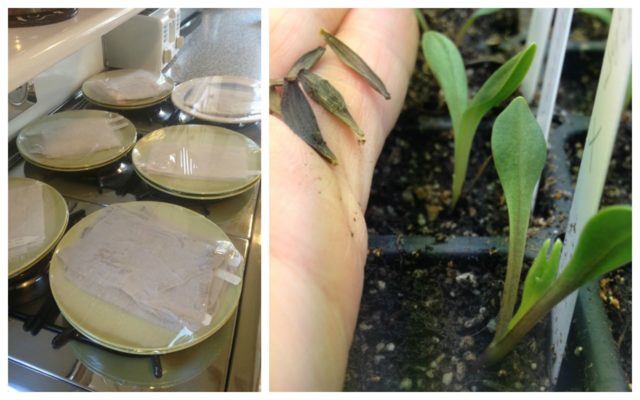 I usually sprout my seeds in February or March. I place the seeds between wet paper towels or a wet cloth and keep them warm (around 76 to 82 degrees). I have an old stove with a pilot lights that is perfect for keeping seeds warm. The seeds typically sprout in 2 to 14 days. Once sprouted I place them in a seed starting mix with the sprouting tip down and half of the seed sticking out of the soil. The seedlings sit on a heated mat keeps them at 76 degrees. They get illumination from grow lights hung five inches above the sprouts for 12 hours each day. Once the plants are three inches tall, they are moved outside into hoop houses where they get acclimated to the outdoors.
I usually sprout my seeds in February or March. I place the seeds between wet paper towels or a wet cloth and keep them warm (around 76 to 82 degrees). I have an old stove with a pilot lights that is perfect for keeping seeds warm. The seeds typically sprout in 2 to 14 days. Once sprouted I place them in a seed starting mix with the sprouting tip down and half of the seed sticking out of the soil. The seedlings sit on a heated mat keeps them at 76 degrees. They get illumination from grow lights hung five inches above the sprouts for 12 hours each day. Once the plants are three inches tall, they are moved outside into hoop houses where they get acclimated to the outdoors.
Erin: I’ve noticed that each breeder’s personality and preferences show up in their creations. Here locally, the emphasis seems to be on big and bright flowers, which for floral designers is not ideal. But your focus is very different! When breeding a new variety what are you looking for?
Kristine Albrecht: We don’t typically grow many big and bright dahlias. Although they may be great show flowers, those are not very popular. We personally love the soft peaches, pinks and whites. We also have a soft spot for oranges but have found they don’t sell as well until the Fall.
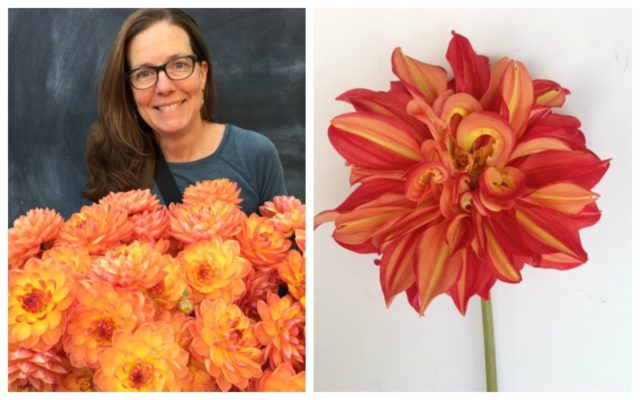 Breeding new dahlia varieties in colors that you prefer is a little hit and miss. Of the 250 dahlia seeds we plant each year, we typically save 10 percent of the dahlia tubers to grow the next year. Since we are looking for good show flowers and good design flowers we are pretty picky about what we keep. With hand pollination I can control both dahlia parents and I choose color combinations I think would look pretty together. When we let the bees do the pollination it helps that we don’t have a lot of yellow blooms as that color is dominant. Dahlia seed pods are like a litter of puppies with no two dahlia seeds having the exact same DNA. Seedlings can also be a bit wild with twisted petals and exposed pollen in the center. This is sometimes desirable for the designers, however, in a show setting judges are looking for classic form and don’t reward wild and novel new looks. Sometimes it’s hard to straddle the show world and the designer world when you have limited planting space.
Breeding new dahlia varieties in colors that you prefer is a little hit and miss. Of the 250 dahlia seeds we plant each year, we typically save 10 percent of the dahlia tubers to grow the next year. Since we are looking for good show flowers and good design flowers we are pretty picky about what we keep. With hand pollination I can control both dahlia parents and I choose color combinations I think would look pretty together. When we let the bees do the pollination it helps that we don’t have a lot of yellow blooms as that color is dominant. Dahlia seed pods are like a litter of puppies with no two dahlia seeds having the exact same DNA. Seedlings can also be a bit wild with twisted petals and exposed pollen in the center. This is sometimes desirable for the designers, however, in a show setting judges are looking for classic form and don’t reward wild and novel new looks. Sometimes it’s hard to straddle the show world and the designer world when you have limited planting space.
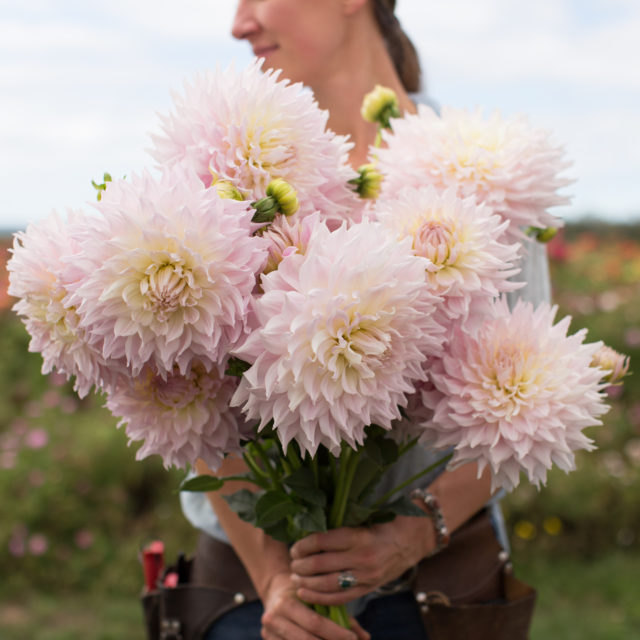 Erin: Your website’s description says KA’s Cloud is classified as an A ID W. For those not familiar with dahlia classifications, can your share what that means?
Erin: Your website’s description says KA’s Cloud is classified as an A ID W. For those not familiar with dahlia classifications, can your share what that means?
Kristine Albrecht: Dahlias are classified with abbreviations that describes the bloom size, form, and color. For example, KA’s Cloud is an A ID W. “A” blooms grow to 8 to 10 inches in diameter. “ID” tells us the petals are not very orderly (Informal Decorative). “W” lets us know the color is white. There are 10 size classifications of dahlias, 20 petal forms, and 16 different color classes. Dahlias can be smaller than 2” or larger than 15”. In 2015, the year KA’s Cloud was introduced, it won the best large bloom award by The American Dahlia Society (The Darrel Hart award). That year it also won the Lynn P. Dudley Award (an awarded based on three blooms being judged at three dahlia shows).
Erin: One of the trickiest parts of successfully growing dahlias is storing them properly through the winter. Can you share your process and timeline for digging and storing tubers? Any special tips or tricks that you’d be willing to share with readers?
Some varieties of tubers can be tricky to store. For example Peaches “n” Cream are hard to store while Cafe au Lait stores easily. Here’s how we dig, divide and store our tubers. We stop fertilizing our dahlia plants a month before we divide. Tubers are known to store better when feeding is stopped. Next, we cut the plants down to 8” a few days to a week before we dig. I only dig as many dahlias as I can divide that day as the tuber eyes stand out better when fresh and make it much easier to divide. We wash all our tubers with water and dip them in a 10% water and bleach solution to kill any bugs like Spotted Snake Millipedes. Next, the tubers are dried out in the shade or in our shed. We divide and label our tubers immediately with a permanent pencil marker or dry the tubers for 24 hours and then mark them with a permanent felt tipped marker. Tubers are placed in plastic shoebox size containers or large rubber tubs with 2” of slightly moist peat moss between the layers. The tubs are stored in a shed that is under deep shade (constant 50 degrees). I also store some tubers wrapped in saran wrap in refrigerators.
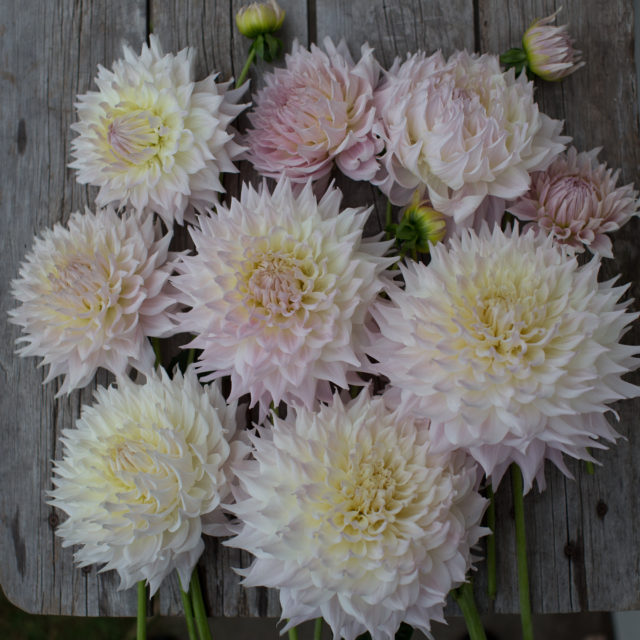 If I had the room, I would have a climate controlled 45 degree cool storage shed. The tubers in my shed tend to start sprouting before I’m ready for them because they get a little too warm and I have to break off the sprouts and force the tubers to push another sprout before planting them out. I check my tubers every month to make sure the conditions in the tubs are good. If the peat is too dry the tubers will look shriveled and their skin wrinkled. If I find this, I will spray a little water on to top layer of peat. If the peat is too wet, I will crack the container lid top and let it dry out a bit before putting the lid back on. A few weeks before planting, I will warm up the tubers to around 65 degrees and add a quarter cup of water to encourage the sprouts to form before putting them into the cool soil. I like to see a growing eye on the tuber before I plant them.
If I had the room, I would have a climate controlled 45 degree cool storage shed. The tubers in my shed tend to start sprouting before I’m ready for them because they get a little too warm and I have to break off the sprouts and force the tubers to push another sprout before planting them out. I check my tubers every month to make sure the conditions in the tubs are good. If the peat is too dry the tubers will look shriveled and their skin wrinkled. If I find this, I will spray a little water on to top layer of peat. If the peat is too wet, I will crack the container lid top and let it dry out a bit before putting the lid back on. A few weeks before planting, I will warm up the tubers to around 65 degrees and add a quarter cup of water to encourage the sprouts to form before putting them into the cool soil. I like to see a growing eye on the tuber before I plant them.
Erin: Thank you so much, Christine, for sharing your knowledge with me and with so many Floret readers and flower lovers. I can’t wait to see what you develop next!
Connect with Santa Cruz Dahlias at Blackbird Farm:

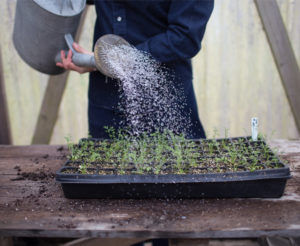
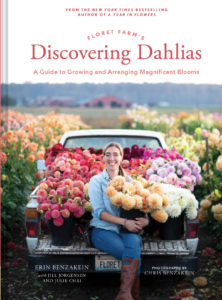
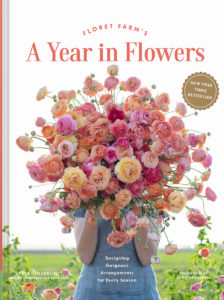



Cindy Deas on
Oh how I wish I could grow some beautiful dahlias! Kudos to Kristine for having the patience for all that work! Her KA’s Cloud are gorgeous!